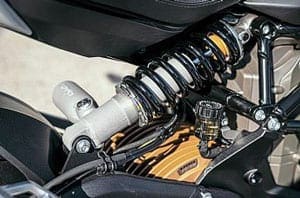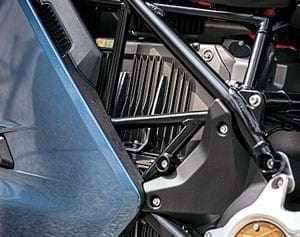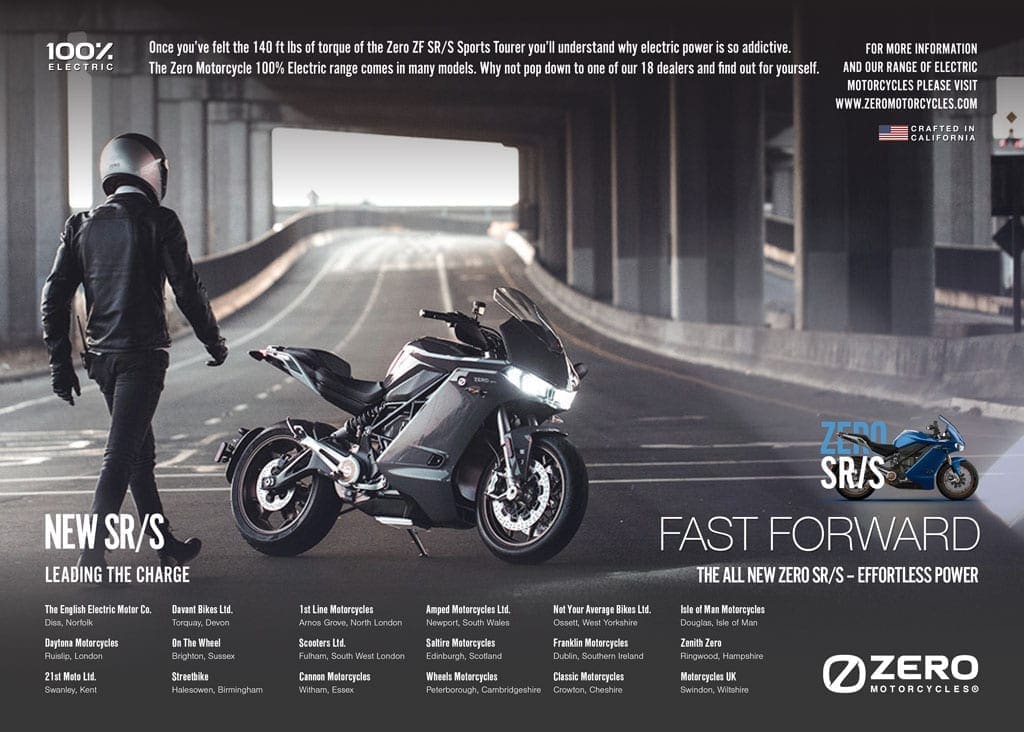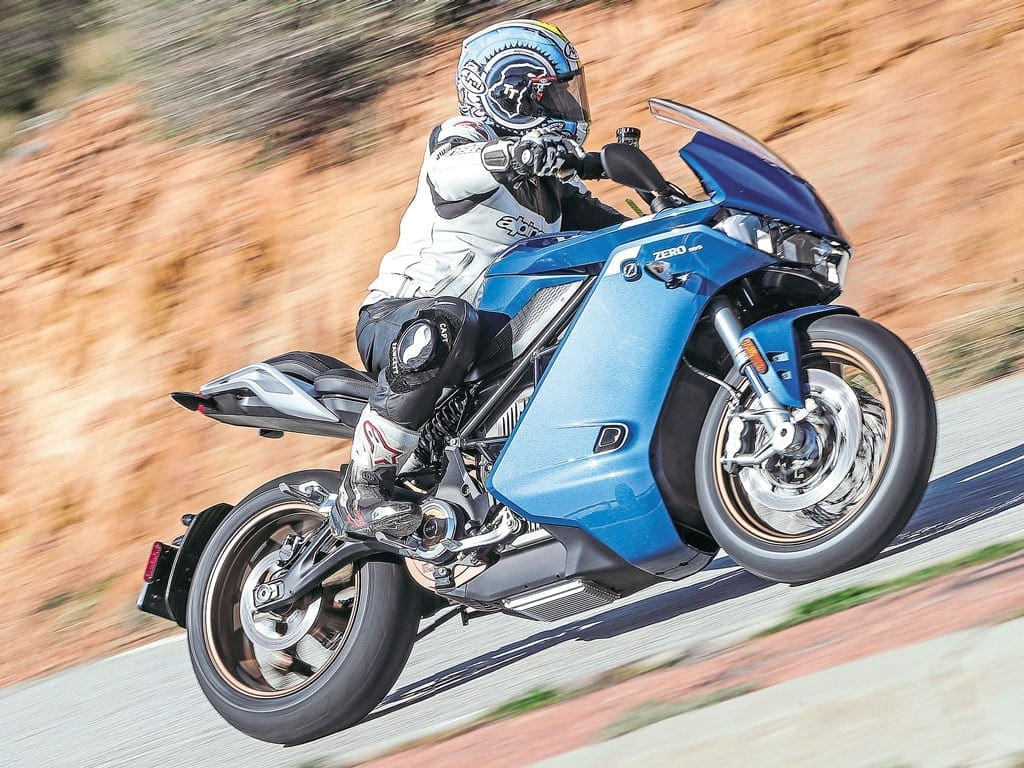
WORDS: Adam ‘Chad’ Child PHOTOGRAPHY: Milagro
Zero, the Californian electric bike manufacturer, has been leading the way since it launched its first fully electric production motorcycle back in 2010.
Now on the back of the successful SR/F, Zero has chosen to launch the sporty SR/S featuring new suspension and sleek bolt-free bodywork, which can improve the range by up to 13% compared to its naked counterpart.
Riding the bike, I find that there’s virtually no noise, just the slight whine of the carbon belt drive on rapid acceleration. I have no gears and no clutch, instant torque and multiple rider aids keeping me safe. Would I swap for a conventional petrol bike? You know, I’m unsure, which might just be a first.
Enjoy everything MSL by reading the monthly magazine, Subscribe here.
Price
There is no hiding the fact the Zero SR/S is expensive at £19,590 for the base model or £21,590 for the premium model, which includes a 6kw rapid charger, heated grips, and aluminium bar ends. But, let’s not forget the monetary savings on purchasing an electric bike. This is the part when I wish I’d done A level maths, not A-level drama.
There is virtually no maintenance as there aren’t any liquids aside from the brake fluid. Even the carbon belt drive will only need an initial adjustment after the first few hundred miles, then it is good for another 20,000. No conventional combustion engine means no filters or spark plugs. A petrol bike service can be between £250-£600 per year, or even more.
Finally, and obviously, the biggest saving will be fuel. This is where I attempt some very rough, estimated costs. To fully charge the 14.4KW battery at home will cost approximately £2. And for argument’s sake, a full charge will last 100 miles, so that’s £1 per 50 miles.
Let’s compare that to a petrol bike that does, say, 50mpg on average running on petrol that costs £1.32 a litre, or £5.99 a gallon. So, the Zero costs £1 per 50 miles compared to a petrol bike which is £5.99 per 50 miles. Therefore, the Zero saves you nearly £5 every 50 miles, or £1 for every 10 miles.
If you travel to work and back, covering 80 miles a day, you would save £8 every day just on fuel. Furthermore, if you are able to plus in for free at work, or have solar panels at home, it’s virtually free commuting. The only thing you’ll have to pay for is insurance and an occasional small service. The Zero SR/S could save you thousands each year.
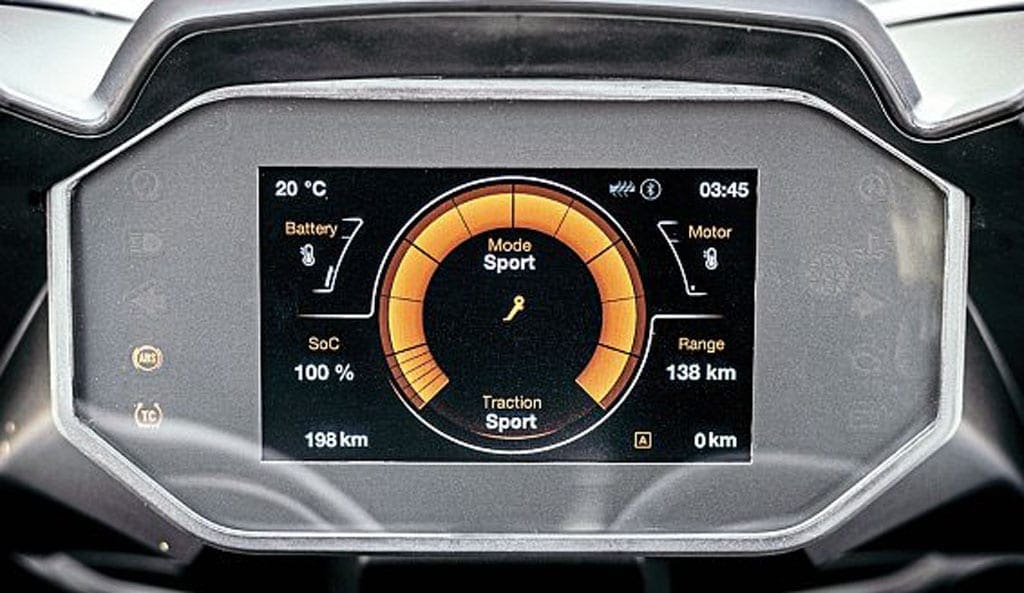
Range
Range is the big question. Interestingly, Zero are happy with their claimed range and have discovered through market resear that the average rider will ride aro 100 miles for a recreational ride, while the average commute is considerably less at around 20 miles.
Zero claim the new sculpted bodywork gives a 13% increase in range, but this is only when prone or tucked in. So, yes, on the motorway, stay tucked in and you’ll enjoy 13% also say that when riding normally the range is the same as the naked SR/F because the S’s bars are higher and the pegs are lower. In other words, the aerodynamic effects of the new fairing are only advantageous when laid on the dummy fuel tank.
City riding gives a 161-mile range, according to Zero, while a constant 55mph returns a 100-mile range. Combining the two: 123 miles. At 70mph on a motorway it should give you 82 miles, and a combination of city and UK motorway, 109 miles. This is all sitting upright; if you are willing to tuck in on the motorway you can add 13%.
In the real world, range ultimately depends on how you ride, your size, weight, wind, hills… even tyre pressures. Some taller, heavy-handed riders had worse range figures than me, but during the test in the south of France, I calculated the figures below.
After a steady ride, with a very short blast on the motorway, I travelled 23 miles, used 20%of the battery’s charge and had a range of 86 miles. Further along, using eco and street modes, I had 43 miles done, 58% battery remaining and a 64-mile range.
Finally, after a very brisk ride, motorway, plus more town work and 70miles done, I had 26% battery remaining and 29 miles remaining. Roughly speaking that’s a 100-mile range, with the rider starting to think about re-charging after 75-80miles of ‘normal’ riding. However, this could be possibly less on faster roads, especially with a heavier rider who’s throttle happy.
When it comes to re-charging you have to think of the SR/S as a smartphone. You’re so dependent on your phone, you’d very rarely allow it to run out of charge. I generally use mine throughout the day and, when I get home or when I go to bed, plug it in at about 20% life – and it’s back to 100% in the morning.
Alternatively, I plug in at my desk in the office and have 100% power for the rest of the day. It’s the same for the SR/S electric bike: get to work, plug in, and have full charge during the working day. A normal 3kw fast charger will have the SR/S back to full power in 4.5 hours on the standard bike, and just 2.5 hours on the premium model. But, as you should have 15-25% battery left, you’re looking at considerably less time: four hours for a 95% charge from flat, two hours on the premium.
On a fast charger it will take 1.3 hours for a 95% charge and just an hour on the premium model. It’s worth noting the last 5% of charge takes the longest, around 30 minutes as the bike is optimising the battery. Therefore, 30 minutes on a fast charge could see a percentage rise from 30% to 90%, barely enough time to order a coffee and drink it.
As electric bike and cars develop, charging stations will become more popular and there are numerous apps on the market that highlight where they are. In fact, you can even pre-book a charging point in advance.
Power and Torque
If you’ve never ridden an electric bike before, you’re in for an enjoyable surprise. Torque is instant; in fact, on the dyno the SR/S makes peak torque from less than 500rpm, then it’s a flat curve of 140ft-lb until it eventually tails off. No gears and no clutch mean it’s easy to launch from a standstill too. At the traffic lights GP it will give most conventional petrol bikes a run for their money to 60mph.
There are four main ride modes to choose from: eco, rain, street and sport. Each mode changes the power characteristics along with peak torque. They also change the level of traction control intervention and re-gen braking (which is like conventional engine braking, but also re-charges the battery).
The modes can be switched on the move, and there are additional custom modes in which you can dictate the bike’s performance – for example, full power, no TC and no engine braking for track action. Each mode illuminates the full-colour TFT dash to a different colour – it’s simple and straightforward.
If you download the Zero app you can even change the modes remotely from your phone. For example, if you’ve stopped for a coffee and have your bike on charge and it starts to rain you can switch from sports to rain – all from the warmth of the coffee shop. You can’t do that on your FJR.
Unlike some petrol bikes, the modes do dramatically change the power and feel of the bike. In eco mode the power is soft, top speed is limited to 120kph, and there is plenty of engine braking, or re-gen – so much so you only need the occasional brush of the brakes, even when you’re making steady progress.
Around town or on the slow coastal roads of southern France the eco mode was more than enough, and I’m guessing in any major city you wouldn’t want any more. If I were comparing its output to a petrol bike, I would think of KTM Duke 390 to 120kph.
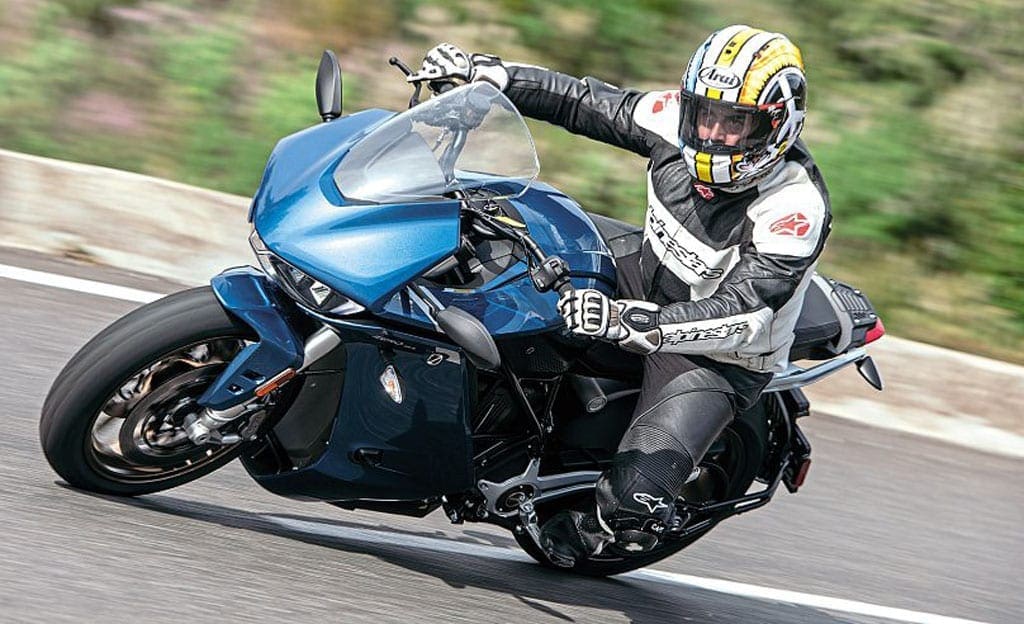
There is a noticeable step up on power from eco and rain to street. Now the Zero is more comparable to a Suzuki SV650 or Kawasaki Z650. Overtakes don’t have to be as calculated, top speed isn’t restricted and the reduced engine braking is instantly noticeable.
Again, on the twisty roads in the south of France, I was more than satisfied with the street mode. Even when we hit the mountain passes, I didn’t want any more power and I was able to have a spirited, enjoyable ride. The street mode should be fine for 80% of the time away from fast A-roads or the motorway.
However, flick into the full sports mode and the SR/S comes alive; acceleration is rapid, no matter what the road speed. There is no lag, no hesitation, you’re instantly propelled towards the horizon. On the motorway I was blown away by the rapid roll-on acceleration from 60mph to 80mph, which took me by surprise.
Unlike a petrol bike, you don’t have to kick back a few gears for instant power, instead it’s always there, and hugely impressive. In this mode it’s hard to compare to a petrol bike as top speed is just 125mph (claimed), but that acceleration – the way it feels when you roll on the throttle – is like a big sports naked, a Z1000 perhaps. The only downside of the sports mode is that it zaps power from the battery, which in turn vastly reduces the range.
Handling, Suspension, Chassis and Weight
Weight has always been an issue with electric bikes. I raced in the TT Zero race on the Isle of Man several times and it was always an issue on a 260kg bike, but although the Zero SR/S is hefty, it’s not too bad, and more comparable to a large, sporty, fully fuelled naked bike.
229kg isn’t light but is more than manageable, and Zero have made significant changes to aid the handling. The fully adjustable Showa suspension looks visually identical to that on the naked F model but is completely new internally, with new springs and a revised shim stack.
The ride is on the sporty side; there isn’t a huge amount of travel on the suspension, which results in a firm ride. This is fine for smooth French roads, but I’d prefer it to be plusher, especially on bumpy B-roads. However, the flip side is the way it controls the weight of the bike, particularly in fast corners and when you apply the strong brakes.
The bars are relatively wide and high, and the pegs are low, which allow you to manhandle the bike with relative ease. Ground clearance is also good for this type of bike, while the Pirelli tyres give excellent feedback. So think sports-touring rather than full-on touring – like a Ninja 1000SX or Suzuki GSX-S1000.
Touring
The new screen and bodywork do a decent job of keeping you out of the windblast, while the pillion now gets good side grab handles and pegs that are not too high. In the accessories catalogue there are even solid panniers and a top box on offer. Don’t forget, there is also storage in the dummy fuel tank, enough for the charging cable, waterproofs or spare gloves. There is even a handy USB charger.
However, unlike a petrol bike, comfort isn’t an issue as you’re going to have to stop every 100 miles or so to re-charge, and that will take enough time to relax and chill out. This isn’t a bike you’re going to be able to cover 500 miles-plus in a day, at least not without careful planning.
Rider Aids
All the rider aids are lean-sensitive, which means cornering ABS and traction control come as standard. These can be changed on the move or de-activated either via custom modes or remotely via your mobile phone.
The TC intervention doesn’t cut the ignition as it would on a conventional bike, it simply reduces the power/ torque. In rain and eco mode you can feel the intervention, but not so much in street or race mode.
In many ways the TC is more beneficial on an electric bike as there is so much instant torque from less than 500rpm and a direct connection from throttle to tyre. On a cold day it would be easy to spin the rear tyre. In the wet I’d strongly advise keeping the TC active.
Verdict
Yes, it’s expensive, compared to a normal petrol bike, but after the initial outlay, running costs are significantly reduced. If you can live with a 80 to 100-mile range, sometimes less, use a bike mainly for commuting and short journeys, then it is a serious contender.
It will be interesting to see how the bikes perform in the real world on faster roads away from the glamour of Cannes. We’re looking forward to a ‘real-world’ MSL test.



